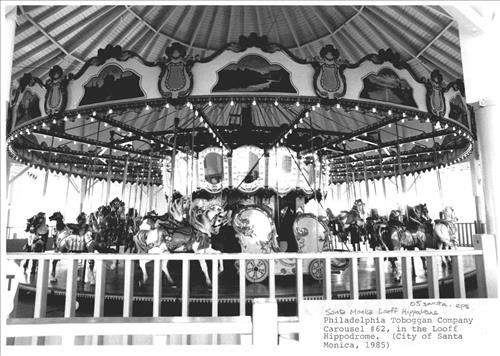Looff’ s Hippodrome (Santa Monica Amusement Pier Carousel Building) is a rare intact example of an early shelter structure built to house a carousel in an amusement park. It is one of only two such structures that remain on the West Coast. 1 Its location on an amusement pier adds to its novelty, and it is also the principal intact historic element of the formerly extensive collection of amusement facilities at the Santa Monica Amusement Pier (Looff's Amusement Pier).
The carousel presently in the Hippodrome is not, however, the Looff carousel originally installed there in 1916, when the Hippodrome opened, but is a Philadelphia Toboggan Company specimen that dates from 1922 and was emplaced in the Hippodrome in 1947.
History
Charles I.D, Looff and his son Arthur were well-known carousel crafters, roller coaster builders, and amusement park operators, who worked primarily on the West Coast after the turn of the century, although Charles' career had begun at Coney Island in 1876. Their center of operations on the West Coast was their factory in Long Beach (now largely demolished). One of their early carousels (1911) and a roller coaster (1924), at the Santa Cruz Beach Boardwalk, and a carousel and its shelter at East Providence, Rhode Island (their headquarters before moving to Long Beach) are described elsewhere in this study.
In 1915-16, the Looffs constructed the "Looff Pleasure Pier," over the waters adjacent to the existing 1000-foot Santa Monica Municipal Pier, which had been advertised since 1905 as the "largest concrete pier in the world."2 Over the next few years, they built an impressive and popular set of attractions. These included the Hippodrome Building with its carousel of their own construction (1916); the "Blue Streak" roller coaster (ca. 1917); a giant rotating swing ride, known as the "Aeroscope"; the Bowling and Billiard Building (ca. 1917); and the La Monica Ballroom (1924), a vast structure of eclectic Byzantine, Persian, and Mission Revival motifs that accommodated 5,000 dancers. The Looff pier also featured picnic shelters and electric trams.
Looffs amusement pier was accessible by electric trolley from Venice and downtown Los Angeles. Its attractiveness and ease of access were also enhanced when the main Santa Monica pier was rebuilt in 1921, widened, and extended to nearly 1600 feet. All the Looff facilities remained to the south of the landward end of the city's pier.4 Looff sold his interests in 1924.
The height of the Santa Monica Amusement Pier's popularity was from 1924, when the La Monica Ballroom opened, through World War II, before the freeway system (begun only in 1939) made more distant coastside attractions and new inland theme parks, such as Knott's Berry Farm (1940) and Disneyland (1955), easily accessible to the burgeoning population and tourist trade of Southern California. The pier's popularity persisted into the 1950s, and the La Monica Ballroom became the first in the nation to televise its programs.
The "Blue Streak" roller coaster, on the other hand, had survived only until 1931. The La Monica ballroom was demolished in 1968.5 Today, other than the Looff pier itself, only the Hippodrome, the Bowling and Billiard Building, now used as a gift shop, and one minor structure survive. The Bowling and Billiard Building, which once featured early automatic pin-setting machinery, has been extensively altered on the interior; for that reason it is not recommended for inclusion in this nomination. Likewise, the Looff Pier and the Municipal Pier have both been so modified that they cannot be said to possess clear historic integrity.
The Carousel
The Carousel presently in the Hippodrome is Philadelphia Toboggan Company #62, a 3-row carousel that began its career in Cumberland Park, in Nashville, Tennessee, in 1922. It was emplaced at Santa Monica in 1947.8 As an intact carousel by a first-rate manufacturer and of the general period represented by the Hippodrome, its presence contributes to the integrity of the structure, since it maintains the building's historic use. The interior of the Hippodrome is, furthermore, being restored to its original appearance to provide an approximation of the historic setting of the former carousel.
On the other hand, the carousel is not the original Looff carousel that was manufactured for the Hippodrome. And, of itself, as a rather typical example of Philadelphia Toboggan Company carousel work in the early 1920s, it is, while quite attractive, not exceptionally early, rare, or unusually distinguished. It was, however, featured in the film "The Sting," and is well known from its appearance in other films and a host of television series episodes.

